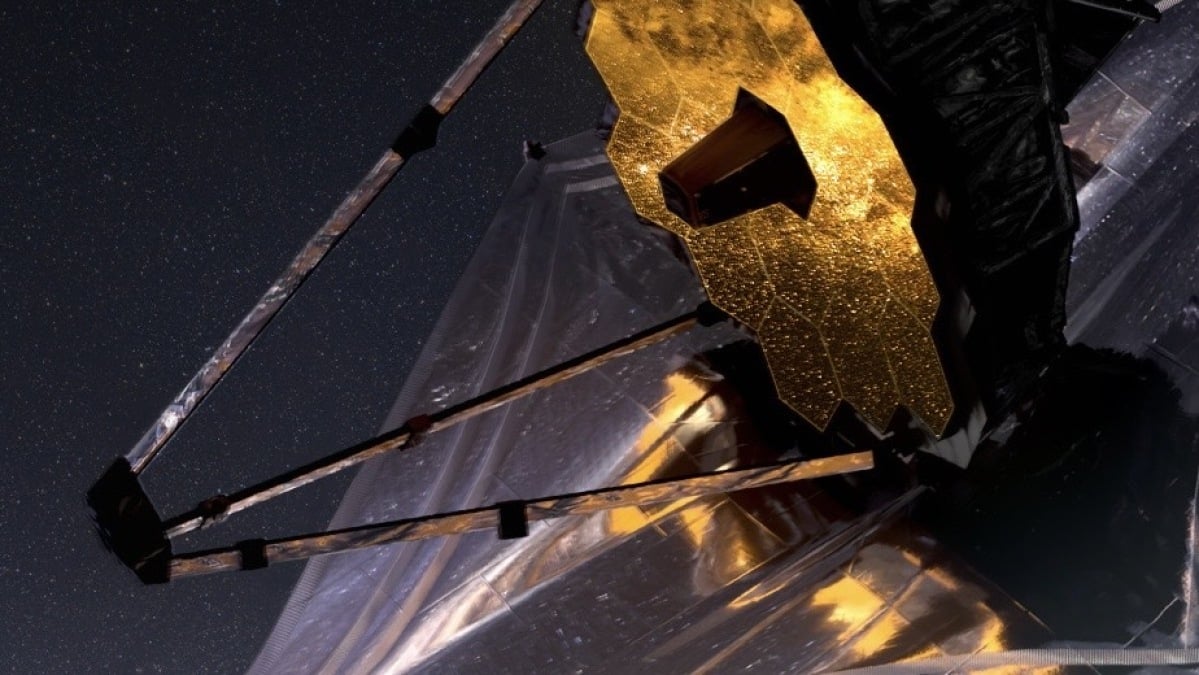
Researchers have confirmed three objects spotted with the James Webb Space Telescope in the early universe are galaxies brimming with unexpectedly old stars. Credit: NASA-GSFC / Adriana M. Gutierrez (CI Lab) illustration
Astronomers say they’ve confirmed that three little red dots observed at the dawn of time by the James Webb Space Telescope are in fact galaxies, flouting theories about the early universe.
Not only that, but researchers say those galaxies seem to host enormous supermassive black holes — perhaps 100 to 1,000 times more massive than the one occupying the center of our own Milky Way. Normally, black holes of this maturity and scale would not be found within young galaxies.
The dots now hold the record for the earliest signatures of “old” starlight — meaning the galaxies, formed shortly after the Big Bang, brim with stars that could already be considered old, said Bingjie Wang, a postdoctoral scholar at Penn State.
“These appear to be packed with ancient stars — hundreds of millions of years old — in a universe that is only 600 to 800 million years old,” said Wang, lead author on the new research about the galaxies, in a statement.
The team took measurements of the light sources to determine what’s generating them and discern the distances of the objects. They published the findings in Astrophysical Journal Letters.
A Penn State-led research team took spectroscopic measurements of the little red dots to determine what’s generating them and discern the distances of the objects. Credit: Bingjie Wang / Penn State / JWST / NIRSpec
The universe is believed to have started some 13.8 billion years ago, shortly thereafter forming the first stars and galaxies in space. Astrophysicists say the light of those initial galactic neighborhoods is still burning, albeit stretched by time and expansion.
The ancient wavelengths exist in infrared, a form of light that human eyes can’t see, but that Webb, a collaboration of NASA and the European and Canadian space agencies, was built to detect with its highly sensitive instruments. In that sense, Webb is a time machine, giving scientists a glimpse of the past.
Mashable Light Speed
But these compact galaxies are perplexing to astronomers because they don’t comfortably fit in the models for cosmic evolution. They would be about 1,000 times smaller than the Milky Way yet be crowded with about the same number of stars.
A Northwestern team of scientists believe early galaxies of the universe may appear bright due to irregular bursts of star formation. Credit: Aaron M. Geller / Northwestern / CIERA + IT-RCDS illustration
The galaxies’ stars must have formed rapidly, in a way that’s new to scientists, in order to be so close together and exist in such an early period, said Joel Leja, assistant professor of astronomy and astrophysics at Penn State.
“For whatever reason, the universe stopped making objects like these after just a couple of billion years,” he said in a statement. “They are unique to the early universe.”
The little red dots were first discovered in 2022. Since then scientists have pored over the data to wring out as much information about the systems as possible. Last October, a separate team led by Northwestern University researchers used advanced computer simulations to assess whether the galaxies could be “bright” without being extremely massive.
Their study suggested that small, less-developed galaxies could undergo irregular bursts of star formation, referred to as — and this is not a joke — “bursty star formation.” Rather than making stars at a steady clip like the Milky Way does, for instance, these galaxies churn out stars inconsistently, with a proliferation all at once, followed by stagnant periods sometimes stretching millions of years before another so-called burst.
“For whatever reason, the universe stopped making objects like these after just a couple of billion years.”
Bursty star formation is common in low-mass galaxies, said Claude-André Faucher-Giguère, a professor of physics and astronomy at Northwestern, though it’s unclear why. The thinking is that a burst of stars, all of the same generation, form, then die off in supernovas a few million years later at about the same time. The gas may then get recycled to form new stars.
But the case is far from closed. The Penn State-led team plans to collect more spectral data from Webb to better understand the star emissions and the potential supermassive black holes, hunting for the specific light signatures that would come from each.
“We have all these puzzle pieces,” Leja said, “and they only fit if we ignore the fact that some of them are breaking.”
Elisha Sauers writes about space for Mashable, taking deep dives into NASA’s moon and Mars missions, chatting up astronauts and history-making discoverers, and jetting above the clouds. Through 17 years of reporting, she’s covered a variety of topics, including health, business, and government, with a penchant for public records requests. She previously worked for The Virginian-Pilot in Norfolk, Virginia, and The Capital in Annapolis, Maryland. Her work has earned numerous state awards, including the Virginia Press Association’s top honor, Best in Show, and national recognition for narrative storytelling. For each year she has covered space, Sauers has won National Headliner Awards, including first place for her Sex in Space series. Send space tips and story ideas to [email protected] or text 443-684-2489. Follow her on X at @elishasauers.
This newsletter may contain advertising, deals, or affiliate links. Subscribing to a newsletter indicates your consent to our Terms of Use and Privacy Policy. You may unsubscribe from the newsletters at any time.
